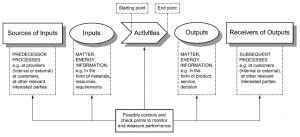
ISO standards have to bear a great deal despite their many revisions and improvements over the years. “It must be done because of ISO compliance”, “way too complicated and effort consuming”, “tons of useless paperwork”… if this is what comes to your mind, you are due for a reality check: your management system either misunderstood or is poorly adapted to the specific context of your organization. Management systems in general and ISO standards in particular, often create a lot of frustration as the bulk of complexity and weight comes from imposing requirements without further questions about the reasons and goals. What if we stop doing it for ISO and instead look for added value of each of our initiatives? What if we do it to put the customer at the heart of our business in order to improve profitability and to make the workplace more engaging and tasks more streamlined and pertinent for our employees?
What Is a Management System?
According to ISO 9000, a management system is a set of interrelated or interacting elements that organizations use to formulate policies and objectives, and to establish the processes that are needed to ensure that policies are followed and objectives are achieved.
The diagram below is a good example. In fact, the challenge is to synthesize the functioning of OUR organization.

Source: http://qualite.master.utc.fr/site_public/travaux/2011/qpo/QPO12/04_graine_qualite/index.html
Key Benefits
An organization that implements a quality management system, for example, could see the following benefits:
The Strength of a Management System
Whether certified or not, the strength of a management system is not in its certification but in its application. Obtaining certification is a business decision on account of customer requirements, competition trends, strategic planning or effort recognition. Using a common set of standards would be the most efficient way to do it to avoid reinventing the wheel every time and to ensure compliance with a certain minimum level of requirements. It is a bit like getting a diploma. Yet even if this decision was forced by external factors, still it must be in line with the actual needs of the organization.
Another reason would be performance improvement. ISO standards provide a summary of requirements that organizations must understand, interpret and adapt to their reality. It is no easy task. For example, Management Review Clause 9.3.1 (ISO 9001: 2015) states:
Top Management is required to review the quality management system at planned intervals to ensure its continuing suitability, adequacy, effectiveness and alignment with the strategy of the organization.
As head of the quality management system (QMS), how do you understand this requirement? What would be the best way to present its benefit to your colleagues? If you ask me, I would make sure I convey to the Top Management the importance of reviewing the QMS results, because after all a lot of time and resources are invested in it. So, why not integrate management reviews in the scheduled quarterly management meetings, if applicable, with the goal to review everything over a period of a year?
Process Approach: at the Heart of the QMS
A process-based approach is one of the foundations of the latest versions of ISO. It is one of the improvements with the most potential for added value since it allows seeing, understanding and revising. What are your key processes? Do they deliver the expected results? The essence of your system is to represent your organization as a set of interrelated and interacting processes, aligned with its mission and focused on its customers. For example, for the Procurement process, we identify the person in charge, inputs, activities, expected results and performance indicators, and relations with other processes.

Schematic representation of the elements of a single process
Source: ISO 9001: 2015
We can thus identify individual elements of our process and eliminate any obsolete elements. Such obsolete elements could be a monthly report that has been prepared for 2 years now but no one uses anymore, outdated work instructions, elements that create no added value for the customer (to be a value-added element, the customer must be willing to pay for this element), etc.
Key Steps
You must start by assessing your current situation to identify the gaps with the ISO requirements and the strengths you can build on. Every organization has a structure that can be used as a foundation. Moreover, your people will feel encouraged and engaged.
Then use the results of your gap analysis to plan for the implementation of the elements needed. Do not underestimate resistance to change, which is the normal human reaction in times of change. While your employees do not need to know ISO clauses, you may want to give them examples in connection with their actual work tasks: benefits for the customer, risk reduction, skills improvement, fewer complaints, etc. Be creative and find new ways to conduct internal audits. If year after year, you ask the same questions to the same people every time, you are missing opportunities for improvement and motivation.
Implementing and maintaining a system requires a great deal of energy to manage change and of creativity to keep your troops motivation while staying on track. We shall discuss this subject in more detail another time.
What else could you do to jazz up your management system? Every year, you streamline and review your processes, you find new ways to keep your employees informed, you integrate your systems instead of working in silos (e.g. quality, environment, and health and safety in the workplace), you use job shadowing to train new internal auditors, etc. Be creative and have fun improving your business performance! The results may surprise you.

Source: fotomelia.com
Some Facts:

Marie-Josée Roy, Eng., M.Env.
Expert – Strategic Management, Performance and Sustainability
Totem Performance organisationnelle